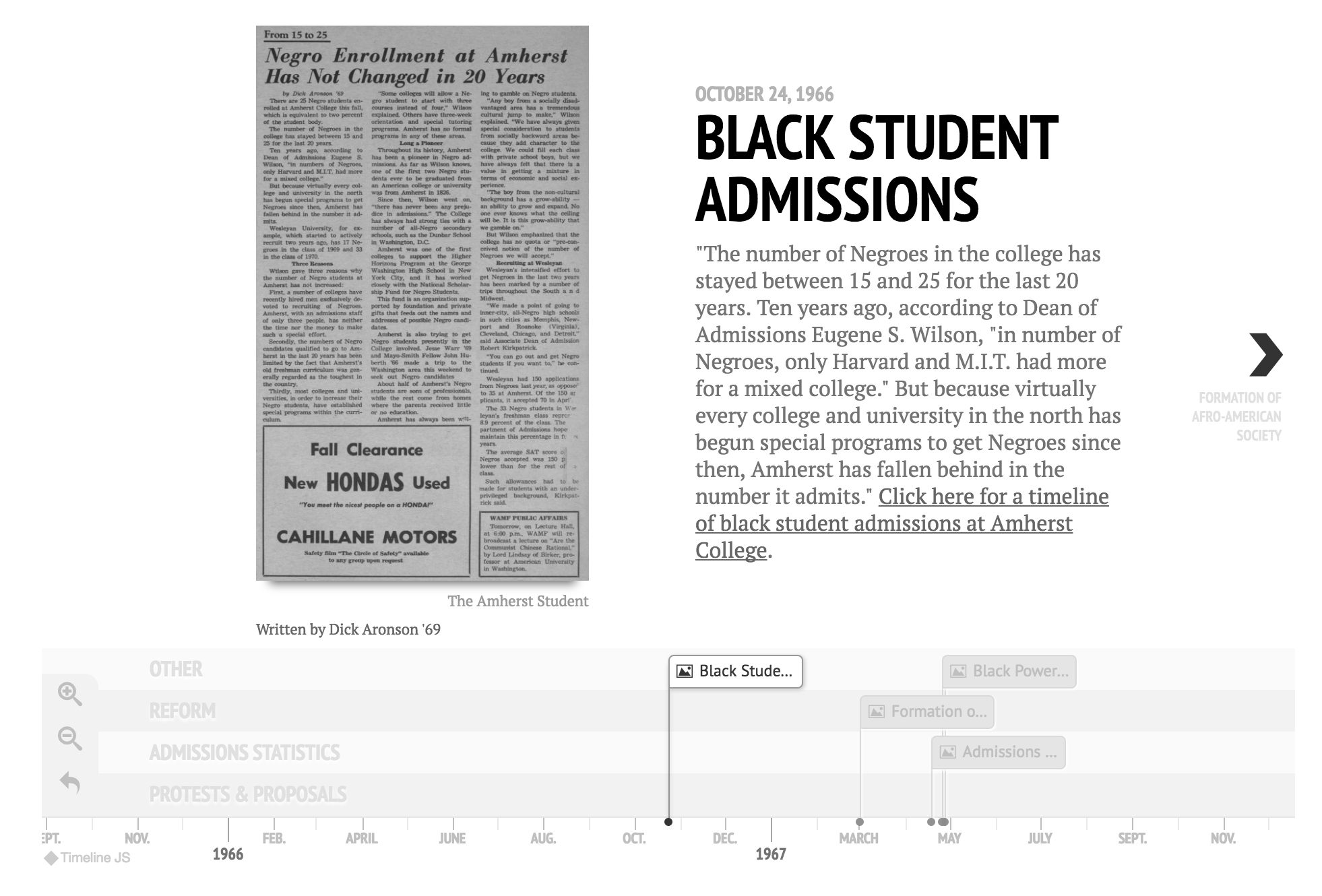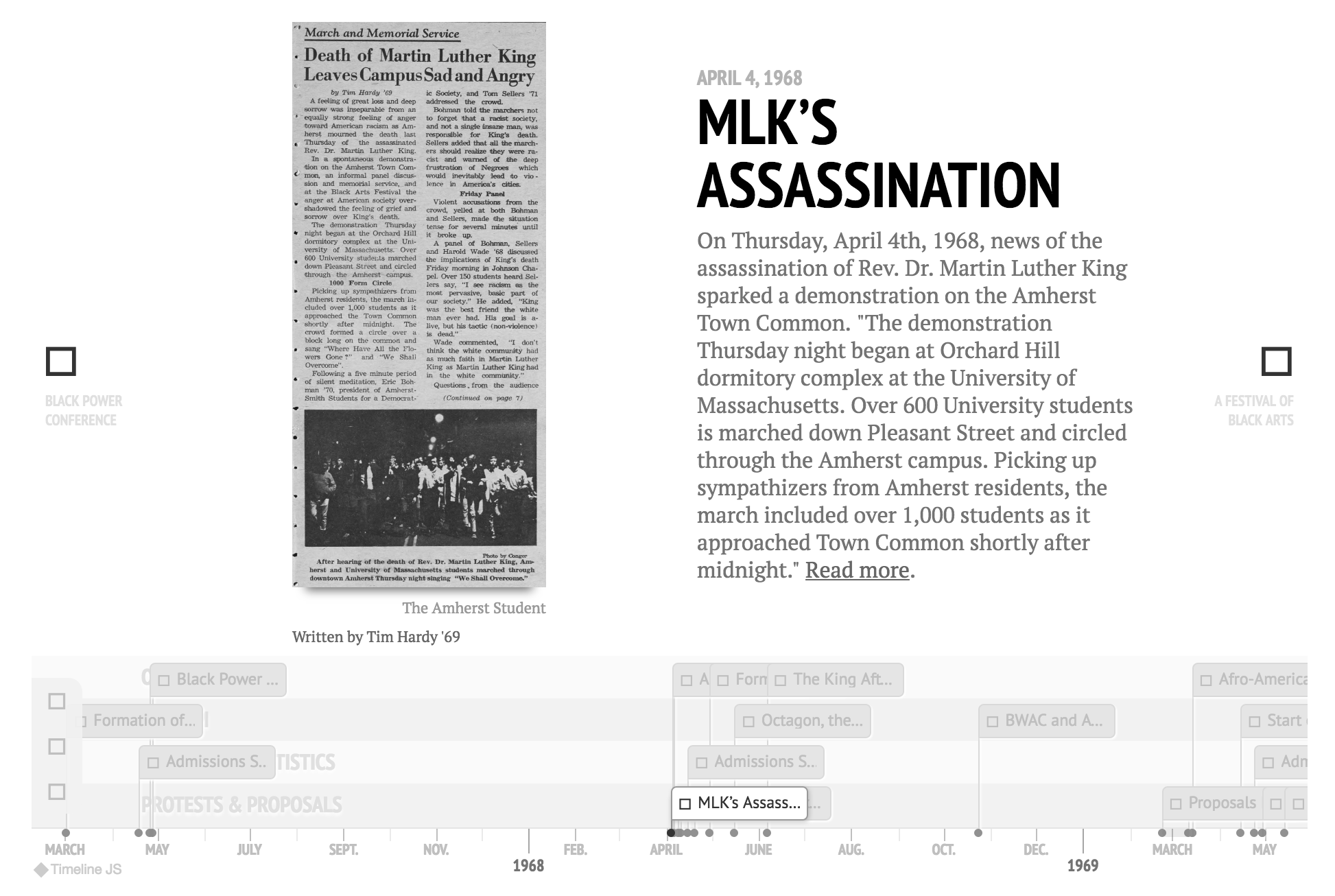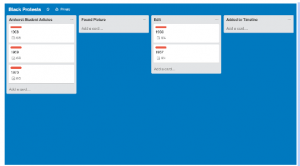Ideas
I knew that I was interested in student protests, but I had  to narrow down my scope and decide how to present it. I started flipping through The Amherst Student and Olio from the sixties and seventies, reading bits and pieces of articles related to protests. Then I came across an extra issue of the newspaper with the title “Blacks Seize Buildings” written in bold, black letters across the headline. I had heard about the takeover of buildings in the 70s and how that led to the creation of the Black Studies Department, but it was my first time reading in detail what had happened.
to narrow down my scope and decide how to present it. I started flipping through The Amherst Student and Olio from the sixties and seventies, reading bits and pieces of articles related to protests. Then I came across an extra issue of the newspaper with the title “Blacks Seize Buildings” written in bold, black letters across the headline. I had heard about the takeover of buildings in the 70s and how that led to the creation of the Black Studies Department, but it was my first time reading in detail what had happened.
Reading through the next few days, this protest seemed to reflect the usual nature of protests at Amherst College. Many people were enraged at the “extreme measures” taken by the Five College Black Community. Other people voiced their support. This made me wonder what led to the takeover and what happened afterwards.
Making Goals
The next step was to define my goals and think about how to put together a digital humanities project. At this step, I consulted Kelcy’s and Sarah’s workshop on project management, and came up with this outline:
Initially, I had wanted to consult other publications that existed during the late sixties and early seventies and see if publications other than The Amherst Student reported or reflected the black student protests. The visit to Mount Holyoke College archives had shown me that the takeover of buildings was not exclusive to Amherst College, and I considered including Five College protests into my project as well. Once I started collecting data, I realized that using The Amherst Student alone would take up most of my time, so I decided to narrow it down to one publication.
In this stage of my research, I consulted other projects that used digital tools to exhibit the history of student protests: Black Liberation 1969 Archive (Swarthmore College) and Student Protests at Northern Michigan University. These two websites helped me to use a timeline to showcase my project. I thought a timeline could best represent and summarize the events surrounding the takeover and could serve as a useful tool for a student or faculty wanting to research the history of student protests.
Data Collection
For data collection, I created a Trello to keep track of the workflow. For each year of The Amherst Student, the workflow was:
- Look through every issue of The Amherst Student to look up relevant articles
- Mark the issues with relevant articles.
- Crop articles using Photoshop.
- Enter information into TimelineJS Google Spreadsheet (include name of publication, date of issue, author, and image).
Refining and Formatting
As I started to collect articles, what seemed like a simple job quickly turned complicated. There were numerous articles during this period related to race relations, but possibly not related the black student protests at Amherst. I had to cut out a number of articles regarding famous speakers visiting the Five College area, housing discrimination against black people in the town of Amherst, or protests in Springfield College for the sake of conciseness and consistency.
The next issue was that even though I weeded out irrelevant articles, there was still a large number of articles left. Putting all these articles into one timeline meant that important information would get lost or overlooked. If I wanted this timeline to be accessible yet comprehensive, I had to think of a different format.
I came up with two solutions for this problem.
The first was to identify the major themes in the articles and created separate timelines for them. The four major themes I could identify were: admissions, Black Culture Center, summer enrichment programs for disadvantaged students, and Black Studies. I created separate timelines for these four themes and made sure these timelines were linked to the main one and vice versa. As a result, someone who wanted to see the summary of events could click through the main timeline and get an understanding of the sequence of events. But if they wanted to read more, there would be a link on the timeline that would say for example “Click here to read more about black student admissions,” and the link would take them to the Admissions timeline (see Figure 1). The admissions timeline would be more detailed, but would still retain important information about protests and proposals (see Figure 2).


The second solution was to create pages that for each entry in the main timeline. Each entry in the timeline would have a “Read more” link at the end that would take you to the page related to the entry. Each page would have articles that were about or in response to a certain event. For example, the entry on Martin Luther King’s assassination on the timeline has a description with an image of an article that represents the entry (see Figure 3). The “Read more” link would take you to the page that would have more articles related to the entry (see Figure 4).


Hopefully, by creating different timelines and multiple pages, the main timeline remains uncluttered and concise. With these two solutions, someone visiting the site does not have to click through every article in order to get an idea of what happened. On the other hand, if someone were interested, they could click through the links to find out in detail what students, administrators, and faculty members were concerned about during this time period.
Conclusion
I learned through my research is that these protests and changes tend to be cyclical. What I mean by that is there would be an action and then a reaction, and then what follows is apathy. For example, the assassination of Martin Luther King led to the creation of many committees and protests, which for the most part faded away after a semester. Or another example is the Black and White Action Committee that organized fundraising events for the Amherst Summer Action Program for disadvantaged students for one year, but could not get enough funds for a second year. Part of this is because during the sixties and seventies, there was so much going on that affected college campuses: the draft and Vietnam War, coeducation, academic policies and more. Students and faculty members were not focused on one issue; they were focused on all of them.
However, the Afro-American Society still instigated changes that reshaped Amherst College for the better. They created a Black Studies Department, they designated Octagon as a Black Culture Center, they increased the number of black students admitted and improved recruitment for such students, and they succeeded in hiring the a black professor and administrator. I decided to end this timeline at the end of the school year in 1971 partly because a lot of the attention from the College was fading away, but mostly because the Afro-American Society achieved the heart of their proposals that were first presented by the Mudge-Marx-Denig Proposal in the spring of 1968. That does not mean the struggle ended here, but that the ground base was established.

